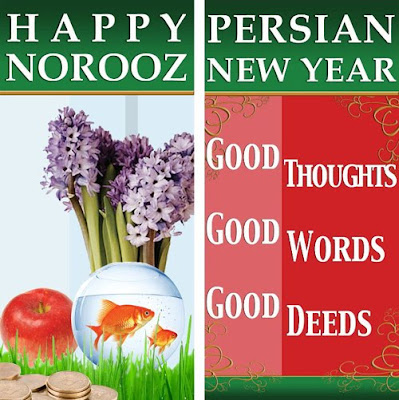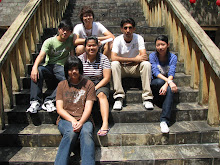Tonight at 1:32:13 in Kuala Lumpur's time it's gonna be our new year
Norooz 3748 Zoroastrian=21.03.2010 =Shahanshahi 2569
HAPPY Norooz!!!!!!!!!!!
Nowrūz (Persian language: نوروز [noʊruːz]), meaning 'New Day') is the traditional ancient Iranian new year festival and also the start day of the Iranian new year. As the European historical name of Iran is Persia, Nowruz is widely referred to as Persian New Year too.
Nowruz is celebrated and observed by Iranian peoples and the related cultural continent and has spread in many other parts of the world, including parts of Central Asia, South Asia, Northwestern China, the Crimea and some ethnic groups in Albania, Bosnia, Serbia and the Republic of Macedonia.
Nowruz marks the first day of spring and the beginning of the year in Iranian calendar. It is celebrated on the day of the astronomical vernal equinox, which usually occurs on March 21 or the previous/following day depending on where it is observed. As well as being a Zoroastrian holiday and having significance amongst the Zoroastrian ancestors of modern Iranians, the same time is celebrated in the Indian sub-continent as the new year. The moment the Sun crosses the celestial equator and equalizes night and day is calculated exactly every year and Iranian families gather together to observe the rituals.
Nowruz was originally a Zoroasterian festival, and holiest of all, and as such has unclear date of origin but was "probably" invented by Zoroaster himself.Since the Achaemenid era the official year has begun with the New Day when the Sun leaves the zodiac of Pisces and enters the zodiacal sign of Aries, signifying the Spring Equinox. The Jewish festival of Purim is probably adopted from the Persian New Year. It is also a holy day for Ismailis, Alawites,Alevis, and adherents of the Bahá'í Faith.
The term Nowruz in writing, first appeared in Persian records in the second century AD, but it was also an important day during the time of the Achaemenids (c. 648-330 BC), where kings from different nations under the Persian empire used to bring gifts to the emperor also called King of Kings (Shahanshah) of Persia on Nowruz.
The UN's General Assembly in 2010 recognized the International Day of Nowruz, describing it a spring festival of Persian origin which has been celebrated for over 3,000 years.During the meeting of The Inter-governmental Committee for the Safeguarding of the Intangible Heritage of the United Nations, held between 28 September – 2 October 2009 in Abu Dhabi, Nowrūz was officially registered on the UNESCO List of the Intangible Cultural Heritage of Humanity.Since 2010, the United Nations General Assembly recognizes March 21 as the "International Day of Nowruz".On 15 March 2010, The United States House of Representatives passed The Nowruz Resolution (H.Res. 267), by a 384-2 vote,"Recognizing the cultural and historical significance of Nowruz, ... .".
Etymology
'Nowruz' comes from two words, now (or a similar term, such as 'nau' or 'nav', with the sounds 'n' and 'v' or 'w'), meaning new in Persian, Kurdish, Avestan, Sanskrit and several other related Indo-European languages. In fact, the English 'new', the German 'neu', the French 'nouveau', the Romanian 'nou', are intimately related to the Indo-Iranian 'now', and roz or ruz or rozh, meaning day in Middle Persian and Persian languages.
Nowruz and the spring equinox
The first day on the Iranian calendar falls on the March equinox, the first day of spring. At the time of the equinox, the sun is observed to be directly over the equator, and the north and south poles of the Earth lie along the solar terminator; sunlight is evenly divided between the north and south hemispheres.
In ca. 11 century CE major reforms of Iranian calenders took place and whose principal purpose was to fix the beginning of the calendar year, i.e. Nowrūz, at the vernal equinox. Accordingly, the definition of Nowruz given by the Iranian scientist Ṭūsī was the following: "the first day of the official new year [Nowruz] was always the day on which the sun entered Aries before noon".




Persepolis (Persian: تخت جمشید meaning the throne of Jamshid) all nations stair case. Notice the people from across the Achaemenid Persian Empire bringing gifts. Some scholars have associated the occasion to be either Mehregan or Nowruz



No comments:
Post a Comment